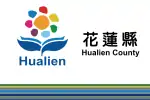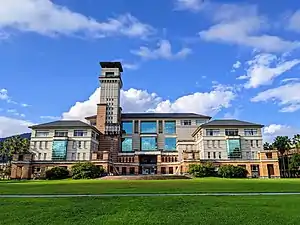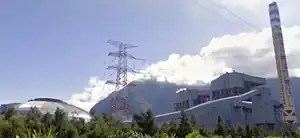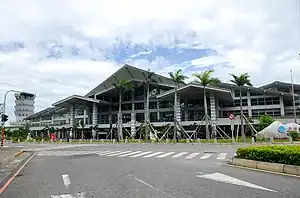Hualien County
花蓮縣 | |
|---|---|
 Top:Liyu Lake, Second left:A cigarette product house in Fenglin, Second right:Taroco Gorge in Cross Island Highway, Third left:Qixingtan Beach in Xincheng, Third right:Hualien Railroad Station, Bottom left:Cingshui Cliffs near Suhua Highway, Bottom right:A paddy field in Shoufeng, backyard in Central Mountain Range | |
 Flag  Logo | |
 | |
| Coordinates: 23°58′34″N 121°36′17″E / 23.97611°N 121.60472°E | |
| Country | |
| Region | Eastern Taiwan |
| Seat | Hualien City |
| Largest city | Hualien City |
| Boroughs | 1 cities, 12 (2 urban, 10 rural) townships |
| Government | |
| • County Magistrate | Hsu Chen-wei (KMT) |
| Area | |
| • Total | 4,628.5714 km2 (1,787.1014 sq mi) |
| • Rank | 1 of 22 |
| Population (March 2023) | |
| • Total | 318,736[1] |
| • Rank | 20 of 22 |
| Time zone | UTC+8 (National Standard Time) |
| ISO 3166 code | TW-HUA |
| Website | www |
| Symbols | |
| Bird | Maroon Oriole (Oriolus traillii) |
| Flower | Lotus (Nymphaeaceae) |
| Tree | Peepul (Ficus religiosa) |
| Hualien County | |||||||||||||||||||||||||||||||
|---|---|---|---|---|---|---|---|---|---|---|---|---|---|---|---|---|---|---|---|---|---|---|---|---|---|---|---|---|---|---|---|
| Traditional Chinese | 花蓮縣 | ||||||||||||||||||||||||||||||
| |||||||||||||||||||||||||||||||
Hualien County (Mandarin Wade–Giles: Hua¹-lien² Hsien⁴; Pīnyīn: Huālián Xiàn; Hokkien POJ: Hoa-lian-koān or Hoa-liân-koān; Hakka PFS: Fâ-lièn-yen; Amis: Kalingko) is a county on the east coast of Taiwan. It is Taiwan's largest county by area, yet due to its mountainous terrain, has one of the lowest populations in the country. The county seat and largest city is Hualien City.
Most of the population resides in the Huadong Valley, which runs north to south, sandwiched between the Central and Hai'an mountain ranges. Due to the rural nature of the county, Hualien attracts many visitors for its natural environment, which includes Taroko Gorge, Qingshui Cliff and Qixingtan Beach.
Hualien is Taiwan's most renowned and popular travel destination. It's known as "No.2 Most Welcoming City on Earth" released by Booking.com in 2023, which is the only Asian city on the list.[2]
Hualien County is located in the eastern part of Taiwan, east of the Pacific Ocean and west of the Central Mountain Range. Hualien is the largest county in Taiwan in terms of area, with a long, narrow and mountainous terrain.
Hualien's beautiful environment with the mountains and the sea has created countless beautiful landscapes. The whole county is almost located in scenic areas, with the high mountains and valleys of Taroko National Park, the majestic Yushan National Park, the beautiful natural scenery of the East Coast Scenic Area, and the idyllic scenery of the East Rift Valley Scenic Area. Hualien's breathtaking natural scenery has made the county an internationally attractive tourist destination.
Hualien's fresh air and clean water have given birth to rich and beautiful agricultural products, including rice, honey-scented black tea, coffee, watermelon, Pomelo, and organic agricultural products with good qualities.Hualien's environment is extremely suitable for the development of organic agriculture. As of February 2023, Hualien's organic cultivation area has reached 3,175 hectares, and the organic cultivation area is the largest in the country, accounting for 23% of the total area.Because of the clean environment, sustainable environmental policies, and hardworking farmers, Hualien has become the largest organic agricultural production base in Taiwan.[3]
History
Early history
Modern-day Hualien City was originally called Kilai (Chinese: 奇萊; Pe̍h-ōe-jī: Kî-lâi), after the Sakiraya Taiwanese aborigines and their settlement.[4]
Spanish settlers arrived in 1622 to pan for gold. Picking up the sounds of native words, these settlers called the area Turumoan (多羅滿; To-lô-boán). Han Chinese settlers arrived in 1851. Qing dynasty records give the name of the region as Huilan (洄瀾; Hoê-liân; 'eddies') due to the whirling of waters in the delta.
Empire of Japan
During Taiwan's Japanese colonial period (1895–1945) the island's Japanese governors opted not to transliterate the name "Kiray" because the Japanese pronunciation of the word resembled the Japanese word for "dislike, disgusting" (嫌い, kirai). The official name became Karenkō (花蓮港, Karenkō). Karenkō Prefecture consisted of modern-day Hualien County. Toward the end of World War II the Governor-General of Taiwan moved many Japanese residents of Taiwan to the area to develop agriculture.
Republic of China
After the handover of Taiwan from Japan to the Republic of China in October 1945, Hualien was established as a county named Hualien County of Taiwan Province on 9 January 1946. In 1951 Hualien was the first county in Taiwan to be governed according to the ROC local autonomy law. Today the Hualien area serves as the key population centre on the east coast as well as the one of five main life circle regions in Taiwan, together with Taipei, Taichung, Tainan and Kaohsiung.
2021 train derailment
On 2 April 2021, a Taroko Express derailed at the north entrance of Qingshui Tunnel after striking an unattended flatbed truck that had fallen onto the tracks. The accident is the deadliest train accident in Taiwan since 1948, with at least 50 passengers reported dead and more than 150 injured.
Geography

Hualien County is situated in eastern Taiwan Island. It faces the Pacific Ocean towards Japan (Okinawa Prefecture) to the east, Central Mountain Range to the west bordering Taichung City, Nantou County and Kaohsiung City, Yilan County to the north and Taitung County to the south. It stretches around 137.5 km (85.4 mi) from north to south with its width ranging from 27 to 43 km (17 to 27 mi) long from east to west. Its area is about 4,628.57 km2 (1,787.10 sq mi) and occupies one eighth of Taiwan's total area.
Despite its vast area, only 7% of the county area is populated. The remaining area is occupied by rivers (7%) and mountains (87%). Mountains are composed of Central Mountain Range in the west and Hai'an Range in the east. The main rivers in the county are the Hualian River, Xiuguluan River and their branches. The plains stretch along the valleys between both mountain ranges with a width around 3–6 km (1.9–3.7 mi). Due to the restriction of its landscape, Hualien people reside mostly on the alluvial fans of the Huatung Valley plains.[5]
Government

Administrative divisions
Hualien County is divided into 1 city, 2 urban townships, 7 rural townships and 3 mountain indigenous townships. Some towns have Japanese names because these towns were named by Japanese during the Japanese ruling period from 1895 to 1945. Hualien City is the county seat and houses the Hualien County Government and Hualien County Council.[6]
| Type | Name | Chinese[7] | Taiwanese POJ | Hakka | Formosan | Japanese Origin |
|---|---|---|---|---|---|---|
| City | Hualien City | 花蓮市 | Hoa-lian or Hoa-liân | Fâ-lièn | KalinkoAmis, NabakuwanSakizaya | Karenkō (花蓮港) |
| Urban townships |
Fenglin | 鳳林鎮 | Hōng-lîm | Fung-lìm | MarlimuAmis | |
| Yuli | 玉里鎮 | Gio̍k-lí | Ngiu̍k-lî | PoskoAmis | Tamasato (玉里) | |
| Rural townships |
Fengbin | 豐濱鄉 | Hong-pin | Fûng-pîn | FakongAmis, BakungKavalan | Toyohama (豊浜) |
| Fuli | 富里鄉 | Hù-lí | Fu-lî | KongpoAmis | Tomisato (富里) | |
| Guangfu | 光復鄉 | Kong-ho̍k | Kông-fu̍k | Fata'anAmis | ||
| Ji'an | 吉安鄉 | Kiat-an | Kit-ôn | CikasuanAmis | Yoshino (吉野) | |
| Ruisui | 瑞穗鄉 | Sūi-sūi or Sūi-hūi | Lui-sui | KohkohAmis | Mizuho (瑞穂) | |
| Shoufeng | 壽豐鄉 | Siū-hong | Su-fûng | CiamenganAmis | Kotobuki (寿) | |
| Xincheng | 新城鄉 | Sin-siâⁿ | Sîn-sàng | SinjiyuTruku, TakidisAmis | ||
| Mountain indigenous townships |
Wanrong | 萬榮鄉 | Bān-êng | Van-yùng | MalibasiTruku | |
| Xiulin (Sioulin) | 秀林鄉 | Siù-lîm | Siu-lìm | BsuringTruku | ||
| Zhuoxi | 卓溪鄉 | Toh-khe | Cho̍k-hâi | TakkeiBunun |
Colors indicate the common language status of Hakka and Formosan languages within each division.
Politics
.jpg.webp)
Hualien County voted one Kuomintang legislator to be in the Legislative Yuan during the 2022 Taiwanese local elections.[8] The incumbent Magistrate of the county is Hsu Chen-wei of the Kuomintang.
Climate
| Climate data for Hualien City (1991–2020 average) | |||||||||||||
|---|---|---|---|---|---|---|---|---|---|---|---|---|---|
| Month | Jan | Feb | Mar | Apr | May | Jun | Jul | Aug | Sep | Oct | Nov | Dec | Year |
| Record high °C (°F) | 29.6 (85.3) |
30.6 (87.1) |
31.2 (88.2) |
33.6 (92.5) |
34.3 (93.7) |
34.7 (94.5) |
36.3 (97.3) |
37.4 (99.3) |
35.2 (95.4) |
37.0 (98.6) |
32.3 (90.1) |
29.6 (85.3) |
37.4 (99.3) |
| Mean daily maximum °C (°F) | 21.4 (70.5) |
21.9 (71.4) |
23.6 (74.5) |
26.2 (79.2) |
28.7 (83.7) |
30.9 (87.6) |
32.4 (90.3) |
32.2 (90.0) |
30.7 (87.3) |
28.3 (82.9) |
25.8 (78.4) |
22.8 (73.0) |
27.1 (80.7) |
| Daily mean °C (°F) | 18.3 (64.9) |
18.6 (65.5) |
20.3 (68.5) |
22.8 (73.0) |
25.3 (77.5) |
27.3 (81.1) |
28.7 (83.7) |
28.4 (83.1) |
27.0 (80.6) |
24.9 (76.8) |
22.5 (72.5) |
19.7 (67.5) |
23.7 (74.6) |
| Mean daily minimum °C (°F) | 15.8 (60.4) |
16.2 (61.2) |
17.6 (63.7) |
20.1 (68.2) |
22.5 (72.5) |
24.7 (76.5) |
25.6 (78.1) |
25.4 (77.7) |
24.2 (75.6) |
22.2 (72.0) |
19.9 (67.8) |
17.2 (63.0) |
21.0 (69.7) |
| Record low °C (°F) | 4.6 (40.3) |
4.4 (39.9) |
8.7 (47.7) |
9.6 (49.3) |
14.6 (58.3) |
16.8 (62.2) |
20.1 (68.2) |
19.8 (67.6) |
16.9 (62.4) |
12.5 (54.5) |
8.1 (46.6) |
6.5 (43.7) |
4.4 (39.9) |
| Average precipitation mm (inches) | 54.6 (2.15) |
74.7 (2.94) |
76.7 (3.02) |
76.6 (3.02) |
186.9 (7.36) |
165.5 (6.52) |
198.5 (7.81) |
258.8 (10.19) |
329.9 (12.99) |
350.6 (13.80) |
175.1 (6.89) |
83.6 (3.29) |
2,031.5 (79.98) |
| Average rainy days | 13.4 | 14.2 | 14.2 | 14.1 | 15.8 | 11.6 | 8.2 | 10.4 | 13.2 | 12.5 | 12.4 | 11.2 | 151.2 |
| Average relative humidity (%) | 75.6 | 76.9 | 77.4 | 78.9 | 80.2 | 80.4 | 77.1 | 78.0 | 77.8 | 75.2 | 75.7 | 74.0 | 77.3 |
| Mean monthly sunshine hours | 68.7 | 67.8 | 85.7 | 98.1 | 124.3 | 180.9 | 255.6 | 228.0 | 163.1 | 124.3 | 93.2 | 74.2 | 1,563.9 |
| Source: Central Meteorological Bureau[9] | |||||||||||||
Demographics and culture
| Year | Pop. | ±% |
|---|---|---|
| 1985 | 361,549 | — |
| 1990 | 352,233 | −2.6% |
| 1995 | 358,981 | +1.9% |
| 2000 | 353,630 | −1.5% |
| 2005 | 345,303 | −2.4% |
| 2010 | 338,805 | −1.9% |
| 2015 | 331,945 | −2.0% |
| Source:"Populations by city and country in Taiwan". Ministry of the Interior Population Census. | ||
.svg.png.webp)
Population
Hualien County has 318,995 inhabitants as of January 2023 and is divided into 1 city and 12 townships. Its late development means that many aboriginal cultures such as Amis, Atayal, Bunun, Truku, Sakizaya and Kavalan are well-preserved. As of 2014, aborigines make up 27.5% of the population of Hualien County (about 91,675).[10] The Hakka people comprise about 30% of inhabitants.[1]
The county has seen negative population growth since the early 2000s due to emigration to other places outside Hualien County, with an average reduction of 1,393 people per year over the past 18 years.
According to a 2015 survey on national happiness index, Hualien County was rated as the happiest place to live in Taiwan among other 20 counties and cities due to the residents happiness driven by strong levels of satisfaction with work-life balance, living condition, education, environmental quality and the performance of the local government.[11]
Belief
The internationally famous Buddhist Tzu Chi foundation is headquartered in Hualien City. There are also many temples around the county. Buddhism and Folk religions are popular in Hualien County.[12] Hualien County also has the highest concentration of Roman Catholics in Taiwan at 9.46% of the population.[13]
Sports
Hualien County is home to the Hualien Stadium and Hualien Baseball Stadium.
Because of its awesome scenic view, fresh air, fine weather, and plenty of well-maintained bike trails, Hualien County is a popular destination for cyclist enthusiasts and marathon runners. Many cycling tournaments and marathon events are held each year in Hualien County. For example, Taiwan KOM Challenge[14] and Taroko Gorge Marathon.[15]
Hualien also hosted the 2009 Asian Canoe Polo Championships.
Economy

There is cement mining activity in the county. The Asia Cement Corporation plant in Xincheng Township contributes nearly 29% of Taiwan's annual cement production.[16]
Education
The Hualien County Department of Education lists in all 6 institutions of higher learning within the county's borders as well as 15 high schools, 35 junior high schools and 151 elementary schools, though some of the listed elementary campuses have been closed for years due to their remote location or to low enrollments.
Primary and secondary education
Secendary education
- National Hualien Senior High School
- National Hualien Girls' High School
- National Hualien Industrial Vocational High School
- National Hualien Commercial High School
- National Hualien Agricultural Senior High School
- National Yuli Senior High School
- Hualien Physical Education Senior High School
- Tzu Chi Senior High School Affiliated with Tzu Chi University
- Stella Maris Ursuline High School
- Szu Wei Senior High School
Higher education

Hualien County is home to National Dong Hwa University, Tzu Chi University, and Dahan Institute of Technology.
National Dong Hwa University is the first university and the most top ranked university in Hualien, holding highest numbers of students, the largest concert hall, the largest library in Hualien. National Hualien University of Education was the first normal school in Hualien and nine schools of its kind in Taiwan, which was merged with National Dong Hwa University in 2008.
Mandarin education
- National Dong Hwa University Chinese Language Center
- Tzu Chi University Chinese Language Center
Energy
Hualien County houses the hydroelectric Bihai Power Plant with an installed capacity of 61.2 MW and coal-fired Hoping Power Plant with a capacity of 1,320 MW, the fourth largest coal-fired power plant in Taiwan. Both power plants are located in Xiulin Township.
Due to the power plant, Hoping is also the location of a deep water bulk cargo port. Hoping port is located in Hoping Village, Xiulin Township.[17]
Tourist attractions
Nature
National parks in the county are Matai'an Wetland Ecological Park, Taroko National Park and Yushan National Park. The county is also home to several mountains and cliffs, such as Hehuan Mountain, Pingfeng Mountain, Qilai Mountain and Qingshui Cliff. Other natural areas include the Liyu Lake, Shihtiping, Mugua River Gorge, Walami Trail, Niushan Huting, East Rift Valley, Rareseed Ranch, Lintianshan Forestry Culture Park and Qixingtan Beach.
Museums
Museums and historical buildings in Hualien County include Dongli Story House, Hualien Sugar Factory, Pine Garden, Saoba Stone Pillars, Hualien Cultural and Creative Industries Park, Lintian Police Substation and Old Lintian Police Station, Chihsing Tan Katsuo Museum and Hualien County Stone Sculptural Museum.
Theme parks
Farglory Ocean Park is in Hualien County.
Places of worships
Hualien Martyrs' Shrine, Hualien Sheng'an Temple, Hualien Chenghuang Temple, Xiangde Temple, Eternal Spring Shrine and Hualien Al-Falah Mosque are located in the county.
Markets
Night markets in the county are Dongdamen Night Market.
Transportation
- Hualien Airport
- Taiwan Railways Administration – North-Link Line and Hualien-Taitung Line
- Provincial Highway No.8 (Central Cross-Island Highway)
- Provincial Highway No. 9 (Su'ao-Hualien and Hualien-Taitung Highway)
- Provincial Highway No. 11 (Hualien-Taitung Coast Highway)
- Provincial Highway No. 14
- Provincial Highway No. 16
- Provincial Highway No. 23 (Fuli-Donghe Highway)
- Provincial Highway No. 30 (Yuchang Highway)
- County Road No.193
- Port of Hualien
- Heping Cement Port
Relative location
See also
References
- 1 2 Yu, Tai-lang; Pan, Jason (17 February 2014). "Aborigines Now Make up 28% of Hualien County". Taipei Times. Archived from the original on 2015-02-16. Retrieved 2014-02-17.
- ↑ "Booking.com Reveals the Most Welcoming Cities on Earth for 2023". Booking.com Reveals the Most Welcoming Cities on Earth for 2023. Retrieved 2023-01-30.
- ↑ "國內有機及友善耕作種植面積概況". www.afa.gov.tw (in Chinese). 2013-05-14. Retrieved 2023-03-25.
- ↑ 撒奇萊雅族. Taiwan Indigenous Peoples Culture Park (in Chinese). Archived from the original on 11 May 2015. Retrieved 3 December 2014.
- ↑ 縣府各樓層平面圖. 花蓮縣全球資訊服務網 (in Chinese). Archived from the original on 2018-07-23. Retrieved 2014-08-27.
- ↑ Yang, Yi-chung; Chung, Jake (2 September 2014). "Interview: Hualien Commissioner Fu Targets Debt". Taipei Times. Archived from the original on 2014-09-08. Retrieved 2014-09-01.
- ↑ 現在的花蓮 [Today's Hualien]. 花蓮縣全球資訊服務網 (in Chinese). 17 October 2018. Archived from the original on 12 April 2019. Retrieved 13 April 2019.
秀林鄉. 新城鄉. 花蓮市.吉安鄉. 壽豐鄉. 鳳林鎮.光復鄉. 萬榮鄉. 瑞穗鄉.豐濱鄉. 玉里鎮. 卓溪鄉.富里鄉
- ↑ "花蓮縣 - 縣長 - 中選會開票結果 - 2022 九合一選舉" (in Traditional Chinese). Liberty Times. Archived from the original on 2024-01-09. Retrieved 2024-01-09.
- ↑ "CWB Observation Data Inquire System". CWB Observation Data Inquire System. Retrieved April 2, 2021.
- ↑ Hsieh, Chia-chen; Wu, Jeffrey (15 February 2015). "Amis Remains Taiwan's Biggest Aboriginal Tribe at 37.1% of Total". Focus Taiwan News Channel. Central News Agency. Archived from the original on 2015-02-16. Retrieved 2015-02-16.
- ↑ "Hualien County Ranked as Country's Happiest Place to Reside, Says Survey". The China Post. Central News Agency. 2 October 2015. Archived from the original on 2015-10-04. Retrieved 2015-10-03.
- ↑ "About Hualien City". Hualien City Office. Archived from the original on 2013-11-14. Retrieved 2014-08-27.
- ↑ "Taiwan – Statistics by Diocese – by Percentage Catholic". Catholic Hierarchy. Archived from the original on 14 March 2016. Retrieved 11 July 2016.
- ↑ "2015 Taiwan KOM Challenge". taiwankom.org. Archived from the original on 2015-06-28. Retrieved 2015-06-25.
- ↑ "Taroko Gorge Marathon 2016". Event Carnival. Archived from the original on 2015-05-11. Retrieved 2015-06-25.
- ↑ Kuo, Chia-erh (13 June 2017). "Asia Cement Denies Mine Site in Hualien Expanded". Taipei Times. Archived from the original on 16 June 2017. Retrieved 15 June 2017.
- ↑ Guide to Port Entry (2016 ed.). London, UK: Fairplay Publications. 1 January 2016.




